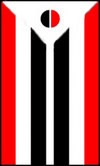Lesson Five - Part One
Questions and Negatives
You've now learned how to express yourself in Arapaho in the present, past and future. However, you've probably noticed that all of our expressions up to this point are "yes" answers. Arapaho makes an important distinction between "yes" and "no" verb forms. Compare:
| I am strong | |
| I am not strong (I am weak) | |
| He is strong | |
| He is not strong | |
| It is strong | |
| It is not strong |
The word for "not" is hoowu-, which is often shortened to hoow-. The different persons are indicated by prefixes rather than suffixes when negative statements are made.
The forms used are as follows (with the verb tei'eihi- 'to be strong' used as an example):
| 1sing | I'm not strong | |
| 2sing | You're not strong | |
| 3sing | S/he’s not strong | |
| II | It's not strong |
Questions are formed with the prefix koo-. Notice that it comes before - not after - the person prefix, which are the same as with the "no" forms. The following are examples of interrogation (asking questions):
| Am I strong? | |
| |
|
| Is it strong? | |
| |
|
Here is a table showing all of the forms:
| 1sing | Am I strong? | |
| 2sing | Are you strong? | |
| 3sing | Is s/he strong? | |
| II | Is it strong? |

